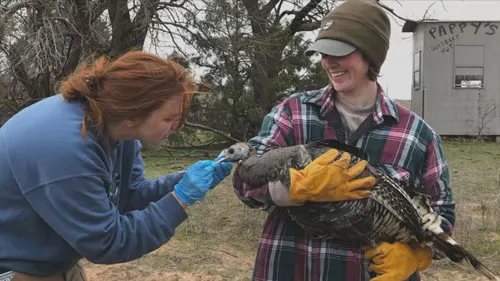Oklahoma Researchers Look Into Concerning Trend About Declining Turkey Population
The Oklahoma Department of Wildlife Conservation said the state's turkey population has declined over the past decade. In this Outdoor Life With Tess, she showed us the research project that's working to get answers.Friday, April 19th 2024, 6:38 am
Oklahoma researchers are looking into a concerning trend. The Oklahoma Department of Wildlife Conservation said the state's turkey population has declined over the past decade. ODWC wants to know why and how to reverse it.
In this Outdoor Life With Tess, she showed us the research project that's working to get answers.
Turkeys are considered the grandest game bird in the U.S., with their thundering sound, distinct strut and gorgeous feathers. They're also a cautious bird, using their sharp eyesight to try and stay one step ahead of predators.
"When you're delicious and you have babies that are basically little chicken nuggets, everything's out to eat you. It's rough. So it's incredible they're able to overcome all that and still exist," said Cody Griffin, OSU PhD Student.
But Griffin said over the past 10 years the turkey population has declined. No one knows why, which is why OSU, the Oklahoma Department of Wildlife Conservation, and Texas A&M Kingsville launched a five-year research project.
"We're not the only state. Other states in the country are doing the same thing. But this is the biggest, most comprehensive study on turkeys in the state of Oklahoma, ever," Griffin explained.
Griffin and ODWC Research Biologist, Alex Cooper, are two of several researchers studying the birds to get answers.
Researchers have been trapping hens and their poults, collecting data through blood samples and measurements, and putting tracking devices on the birds to learn everything they can about turkey behavior.
"Using that movement data allows us to understand if they're surviving, where they're going, where the nests are and if the nests are gonna be successful," Griffin said.

"If there's some insight that can be gained from this or research that says, 'Hey this is one switch we can try to flip' or change the dial setting on to really help the population trajectory, then that would be a really good insight to gain," Cooper said.
Cooper said last year researchers trapped 28 hens in southeast Oklahoma. By the next breeding season, only 8 were still alive. And of three nests tracked, which is a small sample, none were successful.
"It's not out of the normal to see the number of adults that have died. Other studies have found about 50-percent will die," Griffin said. "So that's normal. What's not normal is the fact that we're seeing so many nests being depredated, the proportion of what we have."
Researchers said it's too soon in the study to speculate why this is happening. It could be multiple factors working together.
But they do know turkeys have a history of resiliency, coming a long way from nearly 100 years ago when they were near extinction in Oklahoma.
"And they rebounded, mainly because we implemented laws to prevent overhunting, but also we successfully captured and translocated birds. So they're a very successful conservation story," Griffin said.
And the hope is with more research and understanding, the success story for wild turkeys will continue.
More Like This
October 25th, 2024
October 18th, 2024
October 11th, 2024
Top Headlines
January 27th, 2025
January 27th, 2025
January 27th, 2025








